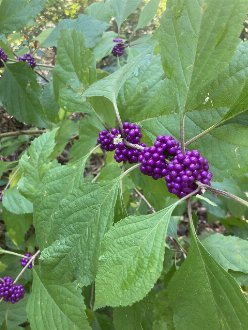American Beautyberry (Callicarpa americana L.)
↑Habitat
Found in open forests in the southeastern US, from the Atlantic and Gulf Coastal Plains into East Texas, southeast Oklahoma, and Arkansas, regions with relatively mild winters and long, hot summers. Natural habitats include forest edges and openings, ledges or bluffs, pine flatwoods, early-successional pine forests, maritime forests (especially in the north of its range), and locally-disturbed sites in forests. Anthropogenic habitats include fence rows, power line right-of-ways, and other anthropogenic forest edges or clearings.
Found on a wide range of soil types including loamy, clayey, sandy, and rocky soils. It is often more common on sites with sandy and/or rocky soil, and/or thin soils, but its growth is best on clayey to loamy soils. It is largely indifferent to soil pH and can be found both on alkaline soils on limestone outcroppings, as well as highly acidic soils in flatwoods deep in the coastal plain. Tolerates a wide range of moisture conditions from moist to dry, but absent from poorly-drained sites.
Some sources describe American beautyberry as a pioneer species, and others describe it as occupying middle stages in plant successional communities; it is more a pioneer species in some habitats, such as in the flatwoods of the South Central Plains (Piney Woods). It is not usually among the first colonizers of unvegetated or severely disturbed sites, but it is a frequent colonizer of sites that have experienced light disturbance that opens up a forest canopy while leaving some trees. In more open, lightly-wooded habitats, such as those that burn regularly, it can persist indefinitely; otherwise it tends to decline in numbers, eventually being eliminated as the forest canopy closes. It is also usually absent from richer sites in mid-successional forests when there is a denser shrub layer.
The relationship of humans to this species has been complex. It has adapted well to forestry and human-induced disturbances, and it has been planted as a landscaping plant in places, but on other sites it has declined due to fire suppression, and in much of its range its habitats have been reduced by clearing of forests and wild land in general. Most of the habitat for this species in Missouri was destroyed by the damming of the white river.
↑Life Cycle
This species is a long-lived shrub that resprouts vigorously and is highly resilient to top-kill. Plants can survive fire, severe drought, or heavy herbivory by resprouting. Although it resprouts readily, this species does not reproduce vegetatively over any significant distance; such spread occurs only by seed.
Seeds are bird distributed, and persist in the seed bank and often sprout following a disturbance.
Plants tend to persist as long as light levels are sufficient. Mortality often occurs gradually on sites where the forest canopy closes and shades this plant out. In the north of its range, inland, and at higher elevations, plants can also be killed by winter cold.
↑Faunal Associations
The fruit is important to numerous songbirds and small mammals. Birds eating the berries include the American Robin, Brown Thrasher, Purple Finch, and Eastern Towhee. Mammals include armadillo, foxes, oppossum, raccoons, squirrels, and deer. Deer also browse the foliage in summer. The protein content of leaves decreases over time, as with many plants, but the attractiveness of this species to deer declines slower than that of many other species.
Cows sometimes browse the twigs in winter, and will also eat the foliage in spring.
↑Uses
This species is occasionally planted in landscaping, where it is valued for its showy and peculiar fruits and its tolerance of a range of soil types. It is relatively sensitive to cold and although it can survive slightly farther north than its native range, it often dies back in cold weather.
Unfortunately, in North America, it is planted less frequently than its non-native relatives purple beautyberry (Callicarpa dichotoma) and japanese callicarpa (Callicarpa japonica), both of which have invasive potential here.
Extracts from this species have been studied for their potential to repel mosquitoes and ticks. Some commercial formulations of an insect repellant derived from this plant are available.
The berries are edible but astringent and not particularly pleasant to eat raw; they are usually described as having a spicy flavor. They are sometimes made into jam or jelly. Relative to Asian species, the American beautyberry is less sweet and more spicy.
Native Americans used this plant medicinally for treating a variety of conditions.
↑Links & External Resources
• American Beautyberry | Fire Effects Information System (FEIS) (About This Site)
• Callicarpa americana (American beautyberry) | USDA PLANTS Database (About This Site)
• Callicarpa americana (Beautyberry) | Missouri Botanical Garden Plant Finder (About This Site)
• American Beautyberry | Virginia Tech Dendrology Factsheets (About This Site)
• Callicarpa americana | Biota of North America Project (BONAP) (About This Site)
• Callicarpa americana | NatureServe Explorer (About This Site)
• Callicarpa americana | Missouri Plants (About This Site)
• American Beautyberry | Maryland Biodiversity Project (About This Site)
• Callicarpa americana L. (American Beauty-berry, French-mulberry) | Digital Atlas of the Virginia Flora (About This Site)




